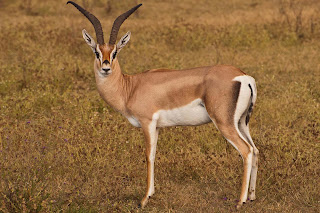
Ngorongoro crater
The impala is a species of antelope found only in Africa. It lives in grasslands, savannas, and on the edges of forests in southern and eastern Africa. In addition to a sufficient amount of grass, the Impala needs a permanent water supply in its habitat. The black-faced impala is one of the impala subspecies that are threatened with extinction due to overhunting.
Impala is medium-sized antelope. It reaches 33 to 39 inches in height at the shoulder. It can weigh between 88 and 165 pounds.
Impalas an run at speeds faster than 60km/h.
Body of impala is covered with reddish or brown hair and black and white marking. Hair in ears and around eyes is white.
They are fleet runners who can leap up to 10m in length and 3m in height.
Males have large, lyre-shaped horns. They are usually 18 to 37 inches long.
Male impalas produce a scent from a gland on their foreheads to advertise their status to rivals.
Horns are used for defense against predators and in the fights for dominance in the herd.
Males will fight for status and territory throughout the mating season, using their antlers as weapons.
Impala produces barks-like sounds to alarm other members of the herd in the case of danger.
Most young impala are born around mid-day as this is the safest time to give birth since most of their enemies are resting.
Impala is herbivore (plant-eaters) which eats grass, herbs, shrubs and leaves on the trees. Impala also eats acacia pods and fruits.
Half of newborn impalas are killed by predators within the first few weeks of life.
Impala lives in herds composed of animals of only one sex. Size and type of the herd depends on the weather conditions and availability of food.
The sex ratio among impala is weighed in favour of the female, with twice as many females born each year.
When the food sources are rich, 6 to 8 dominant males form a herd on a territory of 3 square miles. Females live in larger herds, composed of up to 50 animals. When food sources are scarce – males and females live together in a single herd. Life in the herd provides protection against predators.
The impala is rarely seen on its own. Females and young animals form herds of up to 100 individuals, while males live in a bachelor group of about 60 animals.
Males use a scent produced in the face gland to mark their territory. They also defecate and collect dung to mark the boundaries of the territory.
The name ‘Impala’ come from the Zulu language meaning ‘gazelle’.
Main predators of impala are lions, African hunting dogs, cheetah, leopards, hyenas and pythons.
The impala is native to Africa, and ranges from Angola, Namibia to northeast South Africa and north through Botswana, Zimbabwe, Mozambique, Zambia, Tanzania and Kenya.
Impala is best known by its ability to leap great distance and quickly change direction when it is chased by predators. Impala can jump 10 feet in the air and leap a distance of 33 feet when running.
Impala are diurnal, which means they are most active in the early morning and right before sunset.
Dominance during mating season is established via fights that sometimes end up fatally. Males run toward each other, colliding with their horns. Strength and body size are more important than the size of the horns.
Groups of young impalas are called creches.
Pregnancy lasts 7 months and ends with one baby. Female leaves the herd at the end of pregnancy and hide its baby few days after birth.
Their diets consist of bark, leaves, wood, and stems.
Sucking lasts between 4 and 6 months and results in fast growth of young animals. Young impala will reach maturity at age of one year. Males will leave the herd and join bachelor herds. Females will stay with their mother in the native herd.
Impalas have reddish brown hair with white fur on the underside of the chin, inside ears, on the belly and lips, over the eyes and on the tail.
Average lifespan of impala in the wild is 12 years.










I don’t know how you do it, but every time I read your blog, I feel like you’re speaking directly to me! Your writing is so relatable and insightful, and I always come away with a new perspective on things.